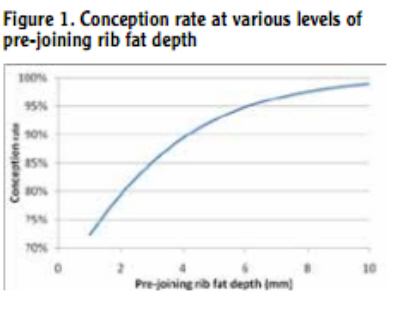



Select For Low Rib Fat To Boost Conception
Selecting for low rib fat as a way of boosting carcase meat yield may be linked to a reduction in maiden heifer conception, according to research conducted in the Beef CRC Maternal Productivity project led by Associate Professor Wayne Pitchford of the University of Adelaide. The research found that selecting for low Rib Fat Estimated Breeding Values (EBVs) to boost carcase meat yield reduced maiden heifer conception rates by more than eight per cent.
This finding is important information for cow-calf producers because reproductive rate is critical for enterprise profitability and the efficiency with which beef is produced.
With the development of BREEDPLAN EBVs for a wide range of traits which impact on the profitability of the beef value chain, producers are faced with challenges to implement these tools in a balanced way, to ensure that selection is targeted at both pre- and post-farm gate profitability.
For traits such as the Rib Fat EBV, the challenge is to apply a breeding objective that is appropriate for both the target market and also the environment in which the cattle are raised.
About the research
As part of the Beef CRC Maternal Productivity project, 382 Angus heifers specifically selected to be divergent in rib fat EBV were monitored for reproductive performance at two research centres, Struan in the south east of South Australia, and Vasse in south west Western Australia.
The average Rib Fat EBV for the high Rib Fat EBV line of heifers was +0.84 mm, compared with the average for the low Rib Fat EBV line of -1.65 mm. Both lines were substantially different to the Angus breed average, which is -0.1 mm for 2009 born calves. The selected heifers represent approximately the highest 10 per cent and lowest five per cent of the Angus breed for Rib Fat EBV.
At both Struan and Vasse, the two heifer lines were managed together during mating and throughout the year to ensure they experienced the same nutritional and environmental conditions. Any differences in conception rates could therefore be attributed to genetic factors. Heifers were joined for nine weeks with pre-joining weight of 360kg and 363kg for the high Rib Fat EBV and low Rib Fat EBV lines respectively (Table 1).
Despite the lines being nearly identical in weight (360kg vs. 363kg), the high Rib Fat EBV heifers had 0.9mm more rib fat (4.5mm vs. 3.6mm) as measured by ultrasound scanning.

Conception rate
The high Rib Fat EBV line had an average conception rate of 91.2 per cent compared with 83 per cent for the low Rib Fat EBV line when considered at an equivalent age. Importantly, the 0.9mm difference in pre-joining rib fat depth between the lines explained much of the difference in conception rate.
Overall, when adjusted for rib fat depth, the difference in conception rate between the high vs. low Rib Fat EBV lines reduced from eight to five per cent and was no longer statistically significant.
A second key finding from the Beef CRC results is the very strong association between heifer rib fat depth at joining and conception rate (Figure 1). Heifers with higher pre-joining rib fat depth had higher conception rates. The greatest increases in conception rate were observed at low levels of pre-joining rib fat depth. For example, an increase in pre-joining rib fat depth from two to three mm was associated with an increase in conception of more than five per cent (79 per cent vs. 85 per cent).
In contrast, an increase in pre-joining rib fat depth from eight to nine mm was associated with a less than one per cent increase in conception rate.

Implication for management and selection
For the first time, the Beef CRC studies clearly show that heifers with a very negative Rib Fat EBV (that is bottom five per cent of the breed) have a greater likelihood of reduced conception rate at their first joining.
Ensuring maiden heifers have sufficient energy reserves prior to their first joining leads to higher conception rates. Cattle breeders therefore need to carefully think about the importance of fat in their cattle, particularly for heifers, and develop strategies to ensure that body energy reserves are adequate to achieve high conception rates.
Importantly, an animal’s genetic merit for Eye Muscle Area (EMA) as assessed using EMA EBVs was not related to heifer conception rate. In terms of breeding, a practical strategy would be to seek bulls with high $index values for a selection index that suits their current production system and the target market. Producers still need to focus on carcass traits, including retail beef yield, and not just adopt selection strategies that focus on Rib Fat EBV in isolation.
For seedstock producers the message is to continue to use an overall selection index that incorporates weaning rate. This strategy allows for animals with the best combination of all traits to be identified, including animals that can sustain heifer calving under tight feed conditions even though they may be leaner.
This research has demonstrated that genetically fatter heifers have higher conception rates. However, data on overall reproductive rate, group feed intake and progeny performance is still being analysed to determine whether this higher initial conception rate translates into higher long-term on-farm productivity or supply chain profitability.


